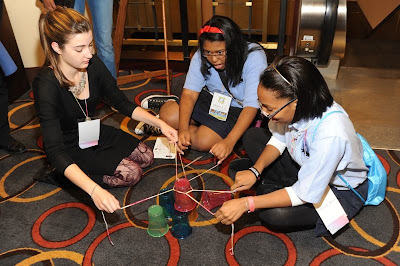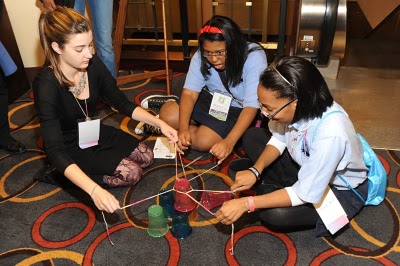 [Photo credit: Karen Peterson]
[Photo credit: Karen Peterson]
Greetings from the desert of the real, otherwise known as downtown Tucson, AZ. It’s my first visit to the Grand Canyon State, and I’ve been really struck by the size of the sky and the sepianess of its light. And all the cacti and sagebrush. But mostly, I’ve been struck by the efficacy, sensibility and change-affecting potential of the National Girls Collaborative Project‘s collaborative model. In a nutshell, for those of you unfamiliar with the organization, the NGCP is a national, NSF-funded project comprised of regional/state collaboratives comprised of girl-serving STEM organizations. Through their website, conferences and this annual institute, the national NGCP assists and educates the regional collaboratives in finding, funding and raising awareness about their local organizations. It’s a fantastic model, and one, that, as I tweeted yesterday, reminds me of Hadoop’s: tap into the resources of many through a central hub, maximizing output and minimizing waste.
Thus far, I’ve learned about the basic components of an NGCP collaborative: it needs a Leadership Team, which weaves together the local organizations through outreach and events, and it needs a Champions Board, ideally filled with prominent high-level industry professionals, educators, science and mathematics representatives and leaders from girl-serving organizations. Each collaborative puts together a kick-off conference at launch date, hosts regular topic forums for potential collaborators and an annual conference that celebrates the collaborative’s successes and showcases the achievements of minigrant recipients.
Meeting members of Leadership Teams from all over the country and learning about both how their collaborative functions and the types of organizations it functions for has been fascinating–a lot of higher-ups at regional Girl Scouts outposts, representatives from women’s engineering and science organizations like SWE and professors and researchers from U Maine, UC Berkley, U Kentucky, Penn State and UT Austin, to name a few. The fact that all these brilliant and very busy women are passionate enough about STEM education and the power of the collaborative model to start and maintain their states’ collaboratives is incredibly inspiring and bodes well for the future of girls in STEM, I think. And for all my fellow Massachusetts citizens, New England already has a collaborative, which you can find out about here.
The day’s sessions just ended, but tonight we’re learning how to make nitrogen ice cream at Flandrau Science Center! If you want to learn how, stay tuned for my next recap!
Share the post "National Girls Collaborative Institute Days 1-2 Recap"

 Follow
Follow